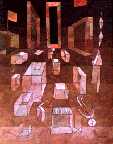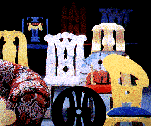

 After World War I there was a turning away from old forms and philosophies among
architects and designers, just as there was among artists and writers. Many of
the same abstract ideas came into play, as did ideas that incorporated the "machine"
aesthetics of the new industrial age. In fact, one of the important trends of
the 20th century would be the increasing parallels between - even merging of -
art and design, which had been separated since the end of the renaissance.
After World War I there was a turning away from old forms and philosophies among
architects and designers, just as there was among artists and writers. Many of
the same abstract ideas came into play, as did ideas that incorporated the "machine"
aesthetics of the new industrial age. In fact, one of the important trends of
the 20th century would be the increasing parallels between - even merging of -
art and design, which had been separated since the end of the renaissance.
In the early 1920's a group of architects and artists, influenced by some of the
ideas of DaDa, formed a movement called de Stijl (Dutch for The Style).
Theirs was a utopian philosophical approach to aesthetics, centered in a
publication called de Stijl, which presented their ideas and designs. The
founder of the publication and leader of the group was Theo van Doesburg, an
architect. Other important participants were Gerrit Rietveld and Piet
Mondrian.
The philosophy was based on functionalism, with a severe and doctrinaire insistence on the rectilinearity of the planes, which seem to slide across one another like sliding panels. All surface decoration except color was to be eliminated, and only pure primary hues, plus black and white were to be allowed.
 The most important thing about this group was their ideas, since they managed
to build very few of their designs. One important exception is Gerrit Rietveld's
Schroeder House, which is the most complete realization of the de Stijl aesthetic.
Not only the house, but also the furnishings and decoration were planned by
Rietveld. In spite of the apparently small output of this group, they would
be very influential on subsequent design styles.
The most important thing about this group was their ideas, since they managed
to build very few of their designs. One important exception is Gerrit Rietveld's
Schroeder House, which is the most complete realization of the de Stijl aesthetic.
Not only the house, but also the furnishings and decoration were planned by
Rietveld. In spite of the apparently small output of this group, they would
be very influential on subsequent design styles.
The initial source of their ideas came from DaDa notions about dispensing with the pretentious elitist design aesthetics of the pre war era. Some of the early work of Frank Lloyd Wright, which had been published in Europe in 1910, influenced their notions about form. Japanese sources were also of significance, though these ideas may have been derived through the work of Wright.
 The Bauhaus school
was established in 1919 in Dessau, Germany by a group of architects, engineers,
and artists led by Walter Gropius. The ideals of this group were social and political
as well as aesthetic. They sought solutions for the problems faced by the working
classes in the depression years of Post World War I Germany. Their concerns included
urban planning, housing, and the development of high-quality, utilitarian mass
production of consumer goods.
The Bauhaus school
was established in 1919 in Dessau, Germany by a group of architects, engineers,
and artists led by Walter Gropius. The ideals of this group were social and political
as well as aesthetic. They sought solutions for the problems faced by the working
classes in the depression years of Post World War I Germany. Their concerns included
urban planning, housing, and the development of high-quality, utilitarian mass
production of consumer goods.
A unique feature of their program was the melding of handicraft and industrial
production methods. Crafts were thought to be the necessary first step in the
training of engineers, architects and industrial designers. In this they
differed from the theoreticians of the Arts and Crafts movement, who resisted
the use of industrial methods and materials; yet the Bauhaus designers shared
the Arts and Crafts veneration of the hand crafts. All engineering and design
students took craft courses as well as painting, drawing, and theoretical
studies in design and color.
The design style of the Bauhaus group owed a great deal to the de Stijl group, some of whom joined the school as teachers. The ideal of form following function was also emphasized, emphasizing the honest and direct use of materials as the most "functional" way to design. The result was spare, rectilinear forms-- in architecture, for example, the structural components of steel, glass, concrete, and other industrial materials were to be used directly and honestly, without imitative form.
The Bauhaus style and teaching methods would become very influential in the teaching of design throughout Europe and the United States, since the teachers emigrated to other universities and design schools in other countries when the Bauhaus was closed by Hitler in 1933. This link will take you to a selection of works by Bauhaus artists and designers. By the outbreak of World War II most were in the United States teaching in major institutions, where they would influence a whole generation of artists and designers. To this day, Bauhaus methods strongly influence the teaching of design in many schools, as can be seen by this directory of Bauhaus-related learning resources.
Among the most
important figures in the Bauhaus school are the architects  Walter Gropius ,
designer of the Pan Am Building in New York;
Mies van der Rohe, who designed the modernist classic, the Barcelona chair,
and a number of important buildings as well. Among the artists associated with
the Bauhaus are Wassily
Kandinsky, Paul Klee,
Joseph Albers, and Johannes Itten, all of whom published and taught their philosophies
of art and design.
Walter Gropius ,
designer of the Pan Am Building in New York;
Mies van der Rohe, who designed the modernist classic, the Barcelona chair,
and a number of important buildings as well. Among the artists associated with
the Bauhaus are Wassily
Kandinsky, Paul Klee,
Joseph Albers, and Johannes Itten, all of whom published and taught their philosophies
of art and design.
 Following World War II the style broadened into what became
known as the
international modern style . The pure form and honest
use of materials continued to define architecture and interior design following
World War II. However, some designers began to explore the broader structural
design potential of industrial materials, and broke with the strict rectilinear
forms of the pre-war era.
Following World War II the style broadened into what became
known as the
international modern style . The pure form and honest
use of materials continued to define architecture and interior design following
World War II. However, some designers began to explore the broader structural
design potential of industrial materials, and broke with the strict rectilinear
forms of the pre-war era.
 Among the architects associated with the international style are
Le
Corbusier, Eero Saarinen,
and Marcel Breuer.
Among the architects associated with the international style are
Le
Corbusier, Eero Saarinen,
and Marcel Breuer.
 In the 1970's, post-industrial design took the Modernist aesthetic to its limit,
with the starkly functional look typified by the Pompidou Center in Paris, designed
by Renzo Piano and Richard Rogers.
In the 1970's, post-industrial design took the Modernist aesthetic to its limit,
with the starkly functional look typified by the Pompidou Center in Paris, designed
by Renzo Piano and Richard Rogers.
Meanwhile a reaction had begun, with its roots in many parts of the history we have examined. This trend came to be known as Post Modernism. The change, which really began in the late 60's, came into its own in the early 1980's. It was influenced by the blurring of fine arts and mass culture previously seen in the Pop Art movement and by the nostalgic revival of a kind of Victorian eclecticism. Surface decoration was once again admired, and other styles were drawn upon freely.
The Post Modern style was a reaction against the rationalism of Modernist design, and even against the formal ideals of modern design as expressed in the principles and elements. Humor and wit became a substitute, or at least a spice, for established notions of "good taste."
 Philip Johnson's AT&T Building in New York (1978-83) was a major example
of the new aesthetic, and it offended the architectural establishment. The roof
line is borrowed from a Chippendale breakfront-- This use of decoration, not
to mention the quotation from a "lesser" design form-- furniture-- appalled
many critics. This use of a visual idea out of its normal context is a deconstructivist
tactic, an approach that moved from literature into all of the arts in the 1970s
and 1980s. Their design influenced not only architecture and furniture, but
also industrial
design.
Philip Johnson's AT&T Building in New York (1978-83) was a major example
of the new aesthetic, and it offended the architectural establishment. The roof
line is borrowed from a Chippendale breakfront-- This use of decoration, not
to mention the quotation from a "lesser" design form-- furniture-- appalled
many critics. This use of a visual idea out of its normal context is a deconstructivist
tactic, an approach that moved from literature into all of the arts in the 1970s
and 1980s. Their design influenced not only architecture and furniture, but
also industrial
design.
 Ettore Sottsas was a successful Italian designer of "modern" forms from the
1940's to the 1960's. Then he became interested in both popular culture and
Indian decorative arts. His work also took on Art Deco qualities. In 1981 he
founded a group of designers, almost all but himself under 30 years of age.
These designers became known as the Memphis group. The
Memphis style has been
called the "ultimate fruit salad" of style. Sottsas himself has said that "Anything
that is tamed by culture loses its flavor after a while, its like eating cardboard.
You have to put mustard on it, or take little pieces of cardboard and eat them
with tomatoes and salad. It's a lot better if you don't eat cardboard at all."
Ettore Sottsas was a successful Italian designer of "modern" forms from the
1940's to the 1960's. Then he became interested in both popular culture and
Indian decorative arts. His work also took on Art Deco qualities. In 1981 he
founded a group of designers, almost all but himself under 30 years of age.
These designers became known as the Memphis group. The
Memphis style has been
called the "ultimate fruit salad" of style. Sottsas himself has said that "Anything
that is tamed by culture loses its flavor after a while, its like eating cardboard.
You have to put mustard on it, or take little pieces of cardboard and eat them
with tomatoes and salad. It's a lot better if you don't eat cardboard at all."
This obviously leads to an irreverent, audacious approach to design, playful and humorous, in which all rules are put aside. Memphis and other Post Modern designers love decoration and color as much as the modernists hated it. The results were quite varied, and borrow from many sources.
 |